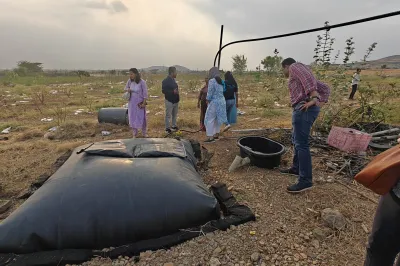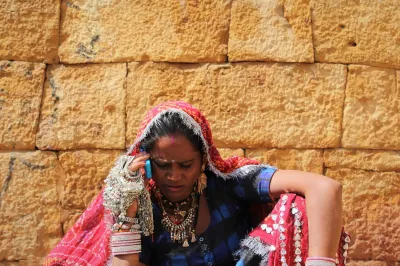Will This Bank Run Away? Women And Mobile Banking In Bihar, India
In Pilkhi village, Nalanda District of Bihar, in northern India, amid kerosene-lit lanterns that fight the encroaching darkness, I have a conversation with about 30 women. These women belong to the poorest families of the village, and have recently become part of self-help groups through a livelihoods project run by the state government.
Although things are beginning to change, over the last twenty years Bihar has become heavily dependent on remittances. In my journeys through two districts, Gaya and Nalanda, it was not unusual to find villages where most working-age men, especially from poor families, are out – living away from their families and working in Delhi or Mumbai, or toiling in the fields of Punjab.
 Woman in rural India weaving with her baby close to her.
Woman in rural India weaving with her baby close to her.
Women head households, manage their financial lives through remittances received, and sometimes seek daily wage labor to boost their meager and fluctuating incomes. They often depend on the local moneylender to buy food during desperate times, deal with health shocks and seek treatment in private hospitals, or for weddings, at exorbitant interest rates that can sometimes be as high as 100% annually.
I had earlier been to a kiosk branch of the State Bank of India (SBI), about two kilometers away from where we sat. The state government's livelihoods project, JEEViKA, has initiated this kiosk branch in partnership with SBI so that women can open bank accounts and receive their remittances through e-transfers at a walkable distance from their homes, rather than relying on more informal and unreliable means. The vision is for them to become regular customers, and use the ultra-small branch's full range of services.
“Will this bank run away?” was one of the first questions I got. About 25 women had opened accounts. “I withdraw the entire amount because am not sure if my money is safe there. We heard that some folks in the village have had trouble with biometric readers.”
A chit fund (Ponzi scheme) passed through the village last year, fleeing overnight with hard-earned savings of many families that they had believed was a life insurance product. That memory will take a while to fade.
“At least with the mattress, we know how much we have kept there, even if it is 2 rupees a day.”
A couple of women in the group talk about their experience of receiving old age pensions from the government. “It comes once in six months at the post office, and we take a bus to get there. Many times we have reached and not been given the amount, asked to come back a day later.” They would much prefer to receive their pensions at this kiosk branch, ideally once in three months instead of six.
The GSMA mWomen Program and VISA Inc have just released a report on women and mobile banking, based on research in five countries: Indonesia, Kenya, Pakistan, Papua New Guinea, and Tanzania. The report finds that women are reliable and often evangelical customers of mobile financial services. However, winning their trust is crucial in retaining them. For example, if an agent doesn’t have cash available during an emergency, a woman is unlikely to give the service another try.
Echoing the voices of women that I met in Pilkhi, the report also finds that women are risk averse. Since they are the ones who manage daily expenses as well as plan for unanticipated costs, women prefer convenient, reliable, secure, and private financial tools that help them secure their families.
The kiosk or ultra-small branch in Pilkhi is branded clearly as an SBI branch. When it comes to banking in rural India, public sector banks are more widely trusted and preferred than private or international banks.
 An ultra small bank branch
An ultra small bank branch
The Pilkhi branch employs a guard and has a generator because the electricity supply is very irregular. It currently operates 1,700 accounts. Typically, from the time you walk into the bank branch it takes about 48 hours to have a functioning account. Most transactions here involve remittances being received by women from family members working in big cities. Mondays have the most amount of volume of withdrawal ranging from Rs 2 to 2.5 lakh (250,000). About 60% of accounts are using the recurring deposit facility, with about Rs 300 average per account. No one is using fixed deposit.
Although this ultra small bank resembles a brick and mortar branch, it is run by an agent, or a CSP as they are referred to India. Every morning he brings cash from the main branch in a nearby town, on his motorcycle, withdrawn through a self-check. The CSP receives 0.5% of every deposit, and 0.25% of every withdrawal, and Rs 20 for every account opened. The CSP in this case, a young man currently studying at a local college, also plans to leave the village and move to Delhi once he graduates.
The GSMA report points out that most mobile financial service providers tailor marketing campaigns to male audiences. They don’t consider women to be core customers, despite their role in managing their families’ money and financial lives Obtaining more relevant client insights would help demonstrate demand for financial services among women and ultimately improve product delivery.
This is not to say that we can label all “women” as a homogeneous segment. In Pilkhi itself, within the group of 30 that I met, there are full time mothers, landless laborers, microentrepreneurs, pension recipients, scholarship recipients and students, and small-scale farmers, all of whom have unique needs.
The Global Findex Data shows that only 37% of adult women have bank accounts in "developing" countries. The number is even lower in South Asia, where only 25% of women have accounts, as compared to 41% of male adults.
The challenges before us are these: how can we get female clients in remote areas to start trusting ultra-small banks and technology, while at the same time getting the bank to view them as bankable clients? How can we take these branches to scale, and get women to use the full range of services that are available? Questions like these are especially pertinent this time of year as millions of people around the world celebrate women’s achievements and emphasize the gender equality on International Women’s Day.
Do chime in with your ideas and experience through comments. You can access GSMA's full report here.
------ Based out of New Delhi, the author manages CGAP’s G2P learning agenda in India, and is the editor of CGAP’s blog.




Comments
Chit funds are not
Chit funds are not necessarily ponzi schemes. A chit is a pool of equal amounts of monthly savings to be contributed for a finite number of years by members of a closed group, each of whom is eligible to borrow from the pool at a rate of interest determined by the would-be borrower's intensity of need, with the interest payment being shared by all members of the group in the form of reduced monthly payments. The Government of Kerala runs several chit funds through the Kerala State Financial Enterprises Ltd. If properly regulated, the Chit fund or the Committee, as it is called in North India, is an extremely viable form of savings intermediation The risk is that the man who manages the chit or the committee, and is entitled to a fee, runs away with the money.
Add new comment